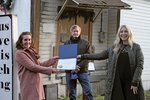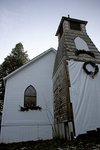For the casual observer, it may not look like much from the outside.
Or from the inside for that matter.
But a small group of Port Ludlow residents have big plans for the Swansonville Church, …
This item is available in full to subscribers.
We have recently launched a new and improved website. To continue reading, you will need to either log into your subscriber account, or purchase a new subscription.
If you had an active account on our previous website, then you have an account here. Simply reset your password to regain access to your account.
If you did not have an account on our previous website, but are a current print subscriber, click here to set up your website account.
Otherwise, click here to view your options for subscribing.
* Having trouble? Call our circulation department at 360-385-2900, or email our support.
Please log in to continue |
|


For the casual observer, it may not look like much from the outside.
Or from the inside for that matter.
But a small group of Port Ludlow residents have big plans for the Swansonville Church, which was recently added to a list of 2,000 historically significant sites in Washington.
Originally built in 1905 on land donated by Swansonville’s namesake, Hans Swanson, the Christian Congregational Church of Port Ludlow, as it was first dubbed, was built to serve the surrounding community.
While Swansonville remained separate from Port Ludlow, the church’s mere 1.2 mile distance from the nearby Puget Mill Company’s operations meant it was situated perfectly to serve the families who worked at the mill but preferred to live in a more rural setting.
Today, a boarded-up doorway, a wall made of tarp, a bell tower that is visibly leaning away from the rest of the building, are the current hallmarks of the Swansonville Church. But, with any luck, the church will outlast its current state of disrepair as it’s outlived so many other things over the past century.
The listing of the church on the Washington Heritage Register is just one step for Terra Coyan, Jessie Michaels and Jake Thomas in their pursuit to preserve, restore and ultimately re-open the church to the community of Port Ludlow.
“I think the fact that this is the last historic community building left standing in Port Ludlow — that really puts it into such a dire need of having it protected,” Coyan said.
“Everything has been removed in Port Ludlow as far as any historical ties,” she added. “Swansonville itself is still intact as far as semi-historic homesteads and so forth, but as far as a public community building, this is the last piece.”
Michaels said their endeavor was not without a personal element, though, as both she and Coyan lived on Werner Road and passed the church daily.
“For quite a few years, we would go by it and see its demise,” Michaels said. “It was getting worse and worse and we said, ‘We have to save it.’”
It was with that very task in mind that the nonprofit Friends of Swansonville was formed in April 2019, under fiscal sponsorship by the Jefferson County Historical Society.
With the help of a real estate lawyer, the nonprofit was able to secure ownership of the property through a quiet title action, given that no clear record of an owner could be determined.
“We have been building a huge, extensive restoration project budget and also game plan for how to do this in phases,” Coyan said.
The most dire repair for the church, she added, is the leaning bell tower. It will be the first large-scale restoration effort the church will see under its new ownership.
The game plan, Coyan said, is still in the works. But the tentative plan is to remove the top of the bell tower, restoring it on the ground and reconstructing the walls and foundation of the tower, before raising the top of the tower back up. The second phase of construction, she added, would likely see the refurbishment of the building’s post-and-pier foundation.
Friends of Swansonville has been working with Brent Davis Construction as it looks to breathe new life into the historic space.
Preliminary estimates indicate the church will need about $500,000 to get it back into a condition where it could serve a congregation once more.
That said, it may be more than just that old-time religion returning to the Swansonville church when it reopens.
“We really want to bring this to the community on a very inclusive level,” Coyan said. “If a church group wants to come here and meet on Sundays, that’s wonderful, but we also want to open it up to different community events.”
Coyan said she could see the church serving as a focal point for workshops and classes that would serve the community rather than strictly just a religious building.
Further driving home the need for a community gathering space, Coyan said, was isolation felt by so many during the COVID-19 pandemic.
“These places need to help the community and be here for the community. It’s unfortunate that we can’t do that right now but that is the goal — for providing a space to people that are in need.”
“It’s also a teaching resource,” Thomas said, and noted that as part of local schools’ history curriculum, a visit to the church could serve to ground students to a physical place that is also historically significant.
In addition to making the list of locations that have contributed significantly to Washington’s heritage, the Swansonville Church has been nominated to be added to the National Register of Historic Places. If accepted, the church could become eligible for tax credits, property tax deductions and code waivers to protect the integrity of the original building.
The organizers and board members of Friends of Swansonville are all volunteers and 100 percent of the funds donated to Friends of Swansonville will go directly to restoration efforts for the church. To donate to Friends of Swansonville, visit www.friendsofswansonville.com.